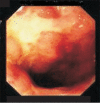Crohn's disease in a Saudi outpatient population: is it still rare?
- PMID: 19568575
- PMCID: PMC2702976
- DOI: 10.4103/1319-3767.45357
Crohn's disease in a Saudi outpatient population: is it still rare?
Abstract
Background/aim: To determine the epidemiology of Crohn's disease (CD) in an outpatient clinic and compare it with data previously reported from different centers in the Kingdom of Saudi Arabia and outside.
Materials and methods: The medical records of all patients with CD seen in the clinic in the period from January 1993 through December 2007 were reviewed. The demographic, clinical data and methods of diagnosis were retrieved.
Results: Over a period of 15 years, we saw 133 Saudi patients with CD. They were predominantly young, with a median age of 26.2 years and male preponderance (2.3:1). The final diagnosis was established within 1 week of presentation in 47% of the patients. The leading symptoms were abdominal pain (88%), diarrhea (70%), bloating (61%), rectal bleeding (50%), weight loss (33%), constipation (24%) and perianal disease (23%). The diagnosis was established by endoscopy and histopathology. Ileocecal involvement was encountered in 40% of the patients.
Conclusion: From the current study, it is obviously possible to diagnose a large proportion of patients with CD in a gastroenterology outpatient clinic. The data revealed a strikingly increased incidence of CD in a mainly young Saudi population in the past few years.
Keywords: Crohn's disease; Saudi Arabia; increasing trend.
Conflict of interest statement
Figures
References
-
- Crohn B, Ginzburg, L, Oppenheimer G. Regional enteritis: A pathological and clinical entity. JAMA. 1932;99:1323. - PubMed
-
- Fiocchi C. Inflammatory bowel disease: Etiology and pathogenesis. Gastroenterology. 1998;115:182–205. - PubMed
-
- Hugot JP, Chamaillard M, Zouali H, Lesage S, Cezard JP, Belaiche J, et al. Association of NOD-2 leucine-rich repeat variants with susceptibility to Crohn's disease. Nature. 2001;41:599–603. - PubMed
-
- Peltekova VD, Wintle RF, Rubin LA, Amos CI, Huang Q, Gu X, et al. Functional variants of OCTN cation transporter genes are associated with Crohn's disease. Nat Genet. 2004;36:471–5. - PubMed
-
- Keighley A, Miller DS, Hughes AD, Langman MJ. The demographic and social characteristics of patients with Crohn's disease in the Nottingham area. Scand J Gastroenterol. 1976;11:293–6. - PubMed
LinkOut - more resources
Full Text Sources
Miscellaneous



